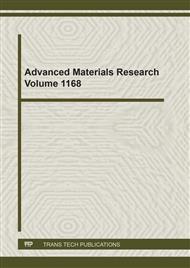[1]
A. Muñoz-Bonilla, M. L. Cerrada, M. Fernandez-Garcia, Introduction to Antimicrobial Polymeric Materials, in: Polymeric Materials with Antimicrobial Activity: From Synthesis to Applications, RSC Publishing, Cambridge, 2014, pp.1-14.
DOI: 10.1039/9781782624998-00001
Google Scholar
[2]
Y. Becker, A short introduction to the origin and molecular evolution of viruses, in: Molecular Evolution of Viruses: Past and Present, Springer US, Boston, 1996, pp.1-5.
DOI: 10.1007/978-1-4613-1407-3_1
Google Scholar
[3]
M.J. Schleiden, Contributions to Our Knowledge of Phytogenesis, Foreign Academies of Science & Learned Societies, 1841.
Google Scholar
[4]
T. Schwann, Microscopical researches into the accordance in the structure and growth of animals and plants, Sydenham Society, London, 1847.
Google Scholar
[5]
J. Rodríguez-Hernández, Polymers Against Microorganisms, in: Polymers against Microorganisms: On the Race to Efficient Antimicrobial Materials, Springer, 2017, pp.1-14.
DOI: 10.1007/978-3-319-47961-3_1
Google Scholar
[6]
J.N. Hahladakis, C.A. Velis, R. Weber, E. Iacovidou, P. Purnell, An overview of chemical additives present in plastics: Migration, release, fate and environmental impact during their use, disposal and recycling, J. Hazard. Mater. 344 (2018).
DOI: 10.1016/j.jhazmat.2017.10.014
Google Scholar
[7]
D.V. Rosato, D.V. Rosato, M.G. Rosato, Plastic Material Formation and Variation, in: Plastics Design Handbook, Kluwer Academic Publishers, Massachusetts, 2001, p.338.
DOI: 10.1007/978-1-4615-1399-5_6
Google Scholar
[8]
J. M. Lagarón, M. J. Ocio, A. López-Rubio, Antimicrobial packaging polymers: a general introduction, in: Antimicrobial Polymers, Wiley, New Jersey, 2012, pp.1-14.
DOI: 10.1002/9781118150887.ch1
Google Scholar
[9]
A. Martínez-Abad, Silver and nanosilver.based plastic technologies, in: J. M. Lagarón, M. J. Ocio, A. López-Rubio (Eds.), Antimicrobial Polymers, Wiley, New Jersey, 2012, pp.287-297.
DOI: 10.1002/9781118150887.ch11
Google Scholar
[10]
B. Aderibigbe, Metal-based nanoparticles for the treatment of infectious diseases, Molecules. 22 (2017).
Google Scholar
[11]
M. Sportelli, M. Izzi, E. Kukushkina, S. Hossain, R. Picca, N. Ditaranto, N. Cioffi, Can nanotechnology and materials science help the fight against SARS-CoV-2?, Nanomaterials. 10 (2020).
DOI: 10.3390/nano10040802
Google Scholar
[12]
R. Pemmada, X. Zhu, M. Dash, Y. Zhou, S. Ramakrishna, X. Peng, V. Thomas, S. Jain, H.S. Nanda, Science-based strategies of antiviral coatings with viricidal properties for the COVID-19 like pandemics, Materials. 13 (2020).
DOI: 10.3390/ma13184041
Google Scholar
[13]
O. Velgosova, E. Mudra, M. Vojtko, L. Veselovsky, Embedding of green synthesized silver nanoparticles into polymer matrix, Bull. Mater. Sci. 44 (2021).
DOI: 10.1007/s12034-020-02349-3
Google Scholar
[14]
D. Keskin, G. Zu, A.M. Forson, L. Tromp, J. Sjollema, P. van Rijn, Nanogels: A novel approach in antimicrobial delivery systems and antimicrobial coatings, Bioact. Mater. 6 (2021).
DOI: 10.1016/j.bioactmat.2021.03.004
Google Scholar
[15]
N. Aziman, L.K. Kian, M. Jawaid, M. Sanny, S. Alamery, Morphological, structural, thermal, permeability, and antimicrobial activity of PBS and PBS/TPS films incorporated with biomaster-silver for food packaging application, Polymers. 13 (2021).
DOI: 10.3390/polym13030391
Google Scholar
[16]
S. Rodríguez-Llamazares, M. Mondaca, C. Badilla, A. Maldonado, PVC/copper oxide composites and their effect on bacterial adherence, J. Chil. Chem. Soc. 57 (2012).
DOI: 10.4067/s0717-97072012000200022
Google Scholar
[17]
H.A. Khan, A. Ahmad, R. Mehboob, Nosocomial infections and their control strategies, Asian Pacific Journal of Tropical Biomedicine. 5 (2015).
DOI: 10.1016/j.apjtb.2015.05.001
Google Scholar
[18]
N. Srivastava, S.K. Saxena, Prevention and control strategies for SARS-CoV-2 infection, in: S.K. Saxena (Ed.), Coronavirus Disease 2019 (COVID-19): Epidemiology, Pathogenesis, Diagnosis, and Therapeutics, Springer Singapore, Singapore, 2020, pp.127-140.
DOI: 10.1007/978-981-15-4814-7_11
Google Scholar


